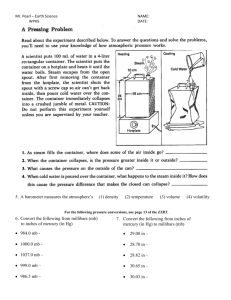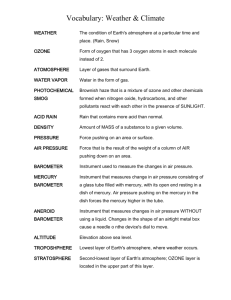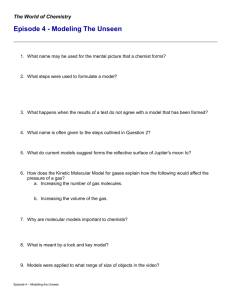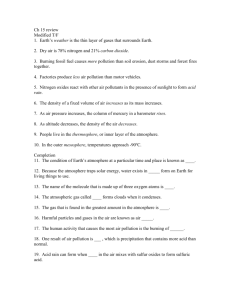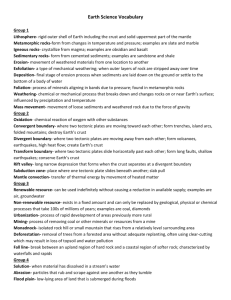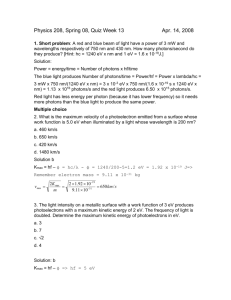Homework 2 Due Wednesday, July 19, 2006 Astronomy/EPS 12
advertisement
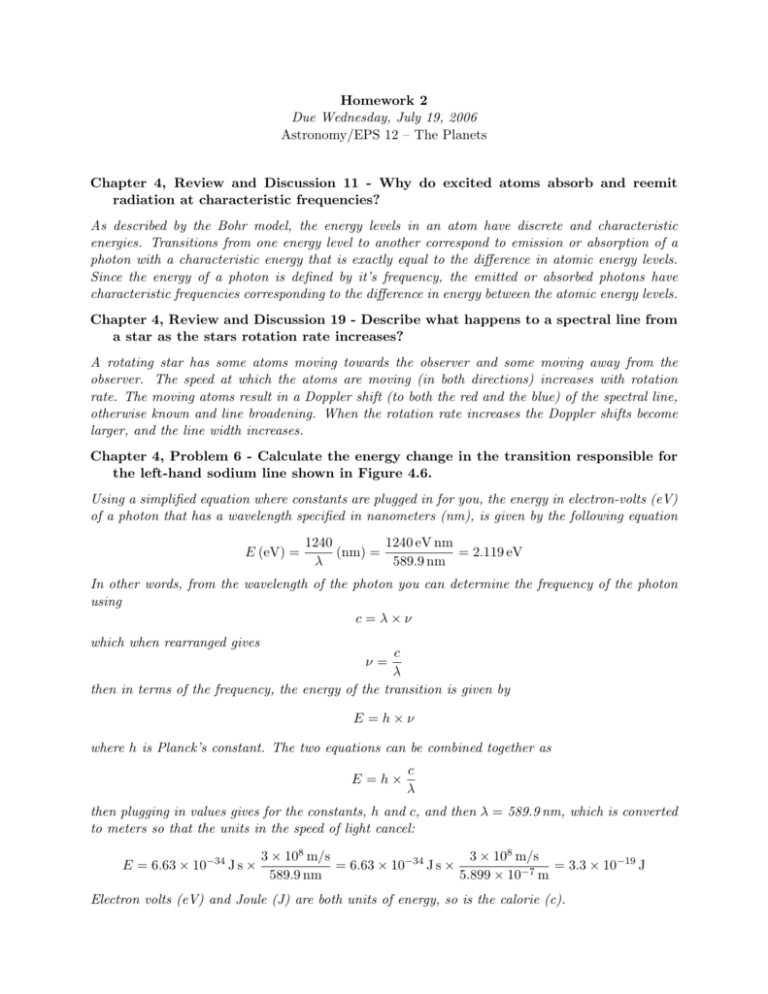
Homework 2 Due Wednesday, July 19, 2006 Astronomy/EPS 12 – The Planets Chapter 4, Review and Discussion 11 - Why do excited atoms absorb and reemit radiation at characteristic frequencies? As described by the Bohr model, the energy levels in an atom have discrete and characteristic energies. Transitions from one energy level to another correspond to emission or absorption of a photon with a characteristic energy that is exactly equal to the difference in atomic energy levels. Since the energy of a photon is defined by it’s frequency, the emitted or absorbed photons have characteristic frequencies corresponding to the difference in energy between the atomic energy levels. Chapter 4, Review and Discussion 19 - Describe what happens to a spectral line from a star as the stars rotation rate increases? A rotating star has some atoms moving towards the observer and some moving away from the observer. The speed at which the atoms are moving (in both directions) increases with rotation rate. The moving atoms result in a Doppler shift (to both the red and the blue) of the spectral line, otherwise known and line broadening. When the rotation rate increases the Doppler shifts become larger, and the line width increases. Chapter 4, Problem 6 - Calculate the energy change in the transition responsible for the left-hand sodium line shown in Figure 4.6. Using a simplified equation where constants are plugged in for you, the energy in electron-volts (eV) of a photon that has a wavelength specified in nanometers (nm), is given by the following equation E (eV) = 1240 1240 eV nm (nm) = = 2.119 eV λ 589.9 nm In other words, from the wavelength of the photon you can determine the frequency of the photon using c=λ×ν which when rearranged gives c λ then in terms of the frequency, the energy of the transition is given by ν= E =h×ν where h is Planck’s constant. The two equations can be combined together as E =h× c λ then plugging in values gives for the constants, h and c, and then λ = 589.9 nm, which is converted to meters so that the units in the speed of light cancel: E = 6.63 × 10−34 J s × 3 × 108 m/s 3 × 108 m/s = 6.63 × 10−34 J s × = 3.3 × 10−19 J 589.9 nm 5.899 × 10−7 m Electron volts (eV) and Joule (J) are both units of energy, so is the calorie (c). Chapter 4, Problem 8 - How many different photo (i.e, photons of different frequencies) can be emitted as a hydrogen atom in the third excited state falls back, directly or indirectly, to the ground state? What are the wavelengths of those photons? The third excited state corresponds to n = 4 and the ground state is n = 1. So there are 3 transitions from the n = 4 state (n =4 to 3,n =4 to 2,n =4 to 1). The atoms that get to n =3 or n =2 can still keep emitting photons and there are 2 transitions from n =3 state (n =3 to 2, n =3 to 1). Finally, there is 1 transition from the n =2 state (n =2 to 1). In total there are 3+2+1=6 transitions. P.90 In Chaisson & McMillan describes the two formulas needed to calculate the energies of these photons. 1 1 E(eV ) = 1.36 − nup nlo where nup is the upper state (or state with larger n) and nlo is the lower state (with smaller n). To convert from eV to wavelength, we use: λ(nm) = 1240 E(eV ) Putting the equation for the energy, E, from the first formula into the second equation, we get 1240 λ(nm) = 1.36 1 nup − 1 nlo So that for the 6 transitions above the wavelengths are E4−to−3 = 1875 nm E4−to−2 = 486.1 nm E4−to−1 = 97.3 nm E3−to−2 = 656.3 nm E3−to−1 = 102.6 nm E2−to−1 = 121.6 nm Chapter 5, Review and Discussion 5 - What advantages does the Hubble Space Telescope have over ground-based telescopes? List some disadvantages. The main advantage of HST is that it is above the atmosphere. This means that it can 1) access wavelength regions that are blocked by the atmosphere – like the ultraviolet and the infrared regions – and 2) the problem of blurring by atmospheric turbulence is circumvented. The disadvantages arise from the fact that the telescope is in space, such that it is difficult and expensive to upgrade and repair, and the equipment that is used must be able to withstand the extreme conditions of space. Chapter 5, Review and Discussion 18 - In what ways do the mirrors in X-ray telescopes differ from those in optical instruments? The mirrors in X-ray telescopes operate at grazing angles, so that they are metal cylinders instead typical curved plates. The X-ray mirrors are placed inside one another (nested) to focus the image, unlike an optical telescope. 2 Chapter 5, Problem 9 - The Moon lies about 380,000 km away. To what distances do the angular resolutions of SST(3”), HST(0.05”), and a radio interferometer (0.001”) correspond at that distance? Using the small angle formula d = 20627100 angle 380, 000 km we plug in the angular measure and get, 1.63 km for SST, 0.027 km for HST and 0.00054 km (or 54 cm!) for a radio interferometer. Chapter 6, Review and Discussion 8 - Name three important differences between terrestrial planets and Jovian planets? Table 6.2 lists a number of differences, the terrestrial planets are closer to the Sun, smaller, rocky, less dense, and have fewer or no moons and no rings. Chapter 6, Problem 12 - How long would it take a radio signal to complete the roundtrip between Earth and Saturn?... The Earth is at 1 AU and Saturn is at 9.5 AU, which means the closest together that they will get is 8.5 AU. 1 AU = 1.5×108 km. Radio signals travel at the speed of light, c = 3 × 105 km/s. So, t (sec) = d (km) c (km/s) The the ROUND-TRIP distance (that’s where the factor of 2 comes from) in kilometers is, 1.5 × 108 km d = 2 × 8.5 AU × = 2.55 × 109 km 1 AU and then the total time isx t= 2.55 × 109 km = 8500 sec = 2.4 hours 3 × 105 km/s To determine how far the space-craft moves in that time, we need to know the velocity and we use the circular orbit velocity formula r GM vc = r with G = 6.7 × 10−11 N m2 /kg 2 , the mass of Saturn, M is 95 Earth masses so, 95 × 6 × 1024 kg = 5.7×1026 kg, and r is given in the problem to be 100,000 km = 1×108 m. Plugging in: r 6.7 × 10−11 × 1024 vc = = 19, 542 m/s = 19.5 km/s 1 × 108 So that in the time it takes to send a signal back and forth, the spacecraft has moved 19.5 km/s × 8500 sec = 165,750 km! Which means there is no way to control the spacecraft in orbit around Saturn in real time. Chapter 7, Review and Discussion 5 - What is the greenhouse effect, and what effect does it have on Earth’s surface temperature? The greenhouse effect is the trapping the energy of near the Earth’s surface by the atmosphere. The greenhouse effect arises because the atmosphere is transparent at visible wavelengths and allows 3 sunlight to heat the surface, while it is transparent in the infrared region, and so it does not allow energy at these wavelengths to leave Earth efficiently. The results is increased surface temperatures due to the atmosphere. Chapter 7, Problem 7 - On the basis of the data in presented in the text, estimate the fractions of Earth’s volume represented by (a) the inner core (b) the outer core, (c) the mantle, and (d) the crust. We use the data in Figure 7.1, which gives the radius, R, at the boundaries of each of these structures, and we use the formula for the volume in a sphere 4 V = πR3 3 The total volume of Earth is 4 VEarth = π(6400 km)3 = 1.1 × 1011 km3 3 (a) for the inner core, R = 1300km, V = 9.3 × 109 km3 and the fraction of total volume is f = V /VEarth = 0.84%. (b) for the outer core ,R = 3500km, V = 1.7 × 1011 km3 (where we calculated the volume at radius 3500km and then subtracted the volume of the inner core) and the fraction of total volume is f = 15.5%. (c) for the mantle, R = 6400km, V = 9.7 × 1011 km3 (where we calculated the volume at radius 6400km and then subtracted the volume within the radius = 3500km) and the fraction of total volume is f = 83.6%. (d) for the crust we calculated volumes at R=6450 km and R =6400 km and subtracted them to get, V = 2.6 × 109 km3 and the fraction of total volume is f = 0.2% Chapter 8, Review and Discussion 7 - What does it mean to say that the Moon is in a synchronous orbit around Earth? How did the Moon come to be in a such an orbit? A synchronous orbit means that the time for the Moon to complete one rotation around it’s own spin axis is exactly equal to the time it takes for the Moon to complete one revolution (orbit) around Earth. The Moon came into this configuration (called tidally locked) due to gravitational interactions between the Moon and the Earth over a long period of time. Chapter 8, Review and Discussion 19 - Explain why Mercury is never seen overhead at midnight in the Earth’s sky? Looking overhead at midnight from Earth means that one is looking directly away from the Sun, so that the only planets that could possibly be visible are the ones with larger orbits than Earth. Since Mercury is closer to Sun than the Earth, it can never been seen in this configuration. Chapter 8, Problem 11 - Assume that a planet will have list its initial atmosphere by the present time if the average molecular speed exceeds one-sixth of the escape speed. What would Mercury’s mass have to be in order for it to still have a nitrogen atmosphere? The molecular weight of nitrogen is 28. Escape velocities and mean molecular speeds are described on pg. 210 of Chaisson & McMillan. The escape velocity (in km/s) is r M vescape = 11.2 r 4 where M is the mass in Earth-masses, and r is the radius in Earth-radii. The average molecular speed (in km/s) is r T vmol = 0.157 m where T is the temperature (in K) and m is the molecular weight. The question asks for the minimum mass, such that 1/6 times the escape speed is less greater than the average molecular speed. (If the escape speed is larger than the molecular speed, then the molecules will not escape). So 1 vmol ≤ vescape 6 r r T 11.2 M 0.157 ≤ m 6 r Plugging in the temperature near the surface of Mercury, T = 600K, the molecular weight of nitrogen, m = 28, and the radius of Mercury, r = 38 Earth radii, we can solve for M : r r 11.2 600 M ≤ 0.157 28 6 0.38 7.2 ≤ M which means that Mercury would have to be 7.2 times as massive as Earth to retain it’s nitrogen atmosphere (this is completely due to the increased temperature on Mercury from being closer to the Sun. 5
